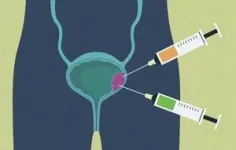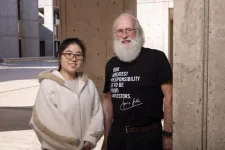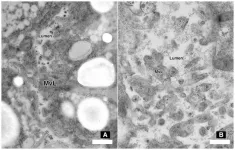(Press-News.org) A new USC study reveals that the challenges that led to a national shortage of affordable housing and soaring home prices were set in motion long ago — and could have been foreseen.
The researchers behind the study say that the problem will only worsen as more natural disasters — such as the devastating Los Angeles area wildfires and large hurricanes — flatten entire communities. Los Angeles County officials estimate that more than 10,000 homes and businesses have been lost so far to the fires that erupted across the region last week.
“A tightly constrained housing supply reduces resilience to absorb losses from unexpected disasters — fires, earthquakes, hurricanes and more. In Los Angeles, this lack of flexibility could rapidly intensify gentrification as relocations strain the existing housing stock,” said Dowell Myers, professor of policy, planning and demography at the USC Price School of Public Policy and the study’s corresponding author.
A tightly constricted housing supply makes it difficult if not impossible to overcome unexpected losses of homes to disasters like wildfires in California. (Photo/iStock)
The study, published in the Russell Sage Foundation Journal of the Social Sciences, traces the origins of the crisis back to the early 2000s. A perfect storm of policy missteps, demographic shifts and economic forces emerged that have severely constrained housing supply, disproportionately affecting millennials and people of color.
The nation now faces a shortage of 4.5 million or more homes.
A crisis decades in the making
The researchers argue that the roots of the crisis began in the early 2000s when easy access to credit for young adults fueled a historic housing bubble. When the bubble burst in 2008 and led to the Great Recession, policymakers overcorrected by tightening mortgage lending standards and limiting funds for new construction.
“These measures came at the worst possible time — just as millennials, the largest generation in 30 years, entered the housing market,” said Myers, who directs the Population Dynamics Research Group at USC Price. “Young home seekers were welcomed with the lowest construction in more than 60 years.”
Using data from the U.S. Census and the American Community Survey, the researchers built a housing-demographic model that tracks how people move through different life stages with housing, such as renting and buying, over time.
They found that from 1990 to 2021, laws passed in 2010 to prevent another housing bubble unintentionally created a mismatch in the market. Stricter credit rules and limited housing supply couldn’t keep up with the millennial generation’s demand for housing. This led to shortages in rental housing first, followed by a shortage in homeowner opportunities. Many millennials delayed buying homes until after 2015, leading to a sudden rush to catch up.
Myers and his co-authors said the factors that led to the housing crisis included:
Severe underestimations of millennial demand: Policymakers and industry leaders miscalculated the millennial generation’s future needs for housing. This oversight only became evident after 2016, when pent-up demand surged.
Overlooked “age waves”: Policymakers failed to consider how shifts in age demographics — especially the increasing number of millennials reaching home-buying age — affected housing demand.
Forgotten lagging effects: Housing and population dynamics are shaped by past events — a fundamental concept that the authors argue has been overlooked in policy discussions. Current homeownership rates reflect decisions made in the past, and today’s population trends are influenced by the characteristics of previous generations.
Flawed demand measurements: Current methods for measuring housing demand fail to account for potential households that cannot form due to housing shortages. This contributed to the underestimates in future housing demand and misinformed policy responses.
Misunderstood homeownership trends: The decline in homeownership rates after the 2008 recession was misinterpreted as a permanent shift in preferences, rather than a delayed response to the housing market crash.
America’s housing crisis: A failure of foresight
Myers credits the work of the late Richard A. Easterlin, professor emeritus of economics at the USC Dornsife College of Letters, Arts and Sciences and a pioneer of linking size of generations to economic consequences. Easterlin’s research explored how changes in fertility rates 20 years prior predict the number of young adults entering the workforce and consumer market — insights that should have informed housing policy and prepared for the millennial demand.
Between 1976 and 1990, birth rates rose by 32%, setting the stage for a surge of 20-somethings moving into cities by 2010, the study found. The 2008 recession delayed their entry into stable jobs and housing, but when millennials began seeking homes after recovery from the Great Recession, supply was scarce.
Homebuilders and local officials likely assumed millennials would stay in apartments with roommates for much longer, but as they approached age 30, this “peak millennial” effect passed and their demand for homeownership surged, Myers explained.
“Easterlin’s timeless lessons were disregarded to our peril and underlie the extreme housing crisis,” Myers said. “We should have seen the millennials coming and made suitable housing plans in advance. How could so fundamental a lesson be disregarded?”
Racial disparities in homeownership recovery
As the housing crisis has deepened, racial and ethnic disparities in homeownership have also widened, with recovery varying significantly across different groups. In their analysis, the researchers examined homeownership trends from 2000 to 2021, focusing on how much these groups were falling short in 2016 and how they recovered by 2021.
In 2016, homeownership among whites was 9% lower than expected. While the gap narrowed over time, by 2021, there were still 4.6% fewer homeowners than anticipated.
Black Americans faced a much larger disparity. In 2016, Black homeownership was 23.2% lower than expected. By 2021, the gap had only slightly improved, with homeownership still 16.3% lower than expected, pointing to a slower recovery in comparison to other groups.
Among Hispanics, homeownership was 12.3% lower than expected in 2016, but the group saw a substantial recovery by 2021. By the end of the study, Hispanic homeownership exceeded expected levels, with a small surplus of 0.4%.
“Our findings point to the need for targeted interventions to address systemic barriers to homeownership and ensure more equitable access to housing for all,” Myers said.
Proactive housing policies in a changing climate
To address the housing crisis, the researchers offer two key solutions: first, shortening the lag time between rising demand and supply by anticipating housing needs over the next five years, and second, standardizing the practice of tracking both population growth and housing availability together, rather than in isolation.
“Housing policy needs to be better at planning for the needs of different age groups and their life stages to avoid mismatches between supply and demand,” Myers said.
“Without proactive policy, we risk not only falling short of meeting demand but also being unprepared with a resilient housing supply that can accommodate victims of climate-driven disasters, like wildfires, or other emergencies that create new demand in an instant.”
Additional revelations are available in the full report.
About the study: Co-authors of the study include Hyojung Lee of Seoul National University and JungHo Park of Kyung Hee University, South Korea.
END
Long before the L.A. fires, America’s housing crisis displaced millions
A USC study reveals how decades of policy missteps fueled today’s housing crisis, pushing the dream of homeownership out of reach for millions, including the largest generation in U.S. history: millennials.
2025-01-14
ELSE PRESS RELEASES FROM THIS DATE:
Breaking barriers: Collaborative research studies binge eating disorders in older Hispanic women
2025-01-14
SAN ANTONIO, Jan. 14, 2025 – Scientists from The University of Texas Health Science Center at San Antonio (UT Health San Antonio) and Trinity University are partnering with the San Antonio Food Bank for a four-year, $2.2 million study on eating disorders in older Hispanic women.
A grant from the National Institute on Aging of the National Institutes of Health is funding this transformative study, which aims to redefine how the intersection of binge eating, food insecurity and health disparities among ...
UVA receives DURIP grant for cutting-edge ceramic research system
2025-01-14
The University of Virginia School of Engineering and Applied Science is set to revolutionize materials science with the development of a state-of-the-art electromagnetic levitation (EML) system, funded by a competitive Defense University Research Instrumentation Program (DURIP) grant. Designed to operate in extreme conditions, the system enables researchers to study ultra-high-temperature ceramics (UHTCs) in their solid and molten states — unlocking new possibilities for aerospace, defense and industrial applications.
Rethinking High-Temperature Research
Traditional methods of studying UHTCs are limited by the challenges of chemical contamination at extreme temperatures. The EML system’s ...
Gene editing extends lifespan in mouse model of prion disease
2025-01-14
Researchers at the Broad Institute of MIT and Harvard have developed a gene-editing treatment for prion disease that extends lifespan by about 50 percent in a mouse model of the fatal neurodegenerative condition. The treatment, which uses base editing to make a single-letter change in DNA, reduced levels of the disease-causing prion protein in the brain by as much as 60 percent.
There is currently no cure for prion disease, and the new approach could be an important step towards treatments that prevent the disease or ...
Putting a lid on excess cholesterol to halt bladder cancer cell growth
2025-01-14
LA JOLLA (January 14, 2025)—Like all cancers, bladder cancer develops when abnormal cells start to multiply out of control. But what if we could put a lid on their growth?
Previous studies showed that a protein called PIN1 helps cancers initiate and progress, but its exact role in tumor development has remained unclear. Now, cancer biologists at the Salk Institute have discovered that PIN1 is a significant driver of bladder cancer and revealed that it works by triggering the synthesis of cholesterol—a membrane lipid essential for cancer cells to grow.
After mapping out the molecular pathway between PIN1 and ...
Genetic mutation linked to higher SARS-CoV-2 risk
2025-01-14
RIVERSIDE, Calif. -- Researchers have identified a novel genetic risk factor for SARS-CoV-2 infection, providing new insights into the virus’ ability to invade human cells. SARS-CoV-2 is the virus that spreads COVID-19.
The study, led by immunologist Declan McCole at the University of California, Riverside, shows that a loss-of-function variant in the phosphatase gene PTPN2, commonly associated with autoimmune diseases, can increase expression of the SARS-CoV-2 receptor ACE2, making cells more susceptible to viral invasion.
A loss-of-function ...
UC Irvine, Columbia University researchers invent soft, bioelectronic sensor implant
2025-01-14
Irvine, Calif., Jan. 14, 2025 — Researchers at the University of California, Irvine and New York’s Columbia University have embedded transistors in a soft, conformable material to create a biocompatible sensor implant that monitors neurological functions through successive phases of a patient’s development.
In a paper published recently in Nature Communications, the UC Irvine scientists describe their construction of complementary, internal, ion-gated, organic electrochemical transistors that are more amenable ...
Harnessing nature to defend soybean roots
2025-01-14
The microscopic soybean cyst nematode (SCN) may be small, but it has a massive impact. This pest latches onto soybean roots, feeding on their nutrients and leaving a trail of destruction that costs farmers billions in yield losses each year. Unfortunately, current methods to combat SCN are faltering as the pest grows resistant to traditional controls. But new research is now offering a glimmer of hope.
A collaborative team of scientists from BASF Agricultural Solutions and the Advanced Bioimaging Laboratory at the Donald Danforth Plant Science Center are working on a potential solution: ...
Yes, college students gain holiday weight too—but in the form of muscle not fat
2025-01-14
With the holidays behind us, many Americans are seeing the numbers on the scale go up a pound or two. In fact, data shows that many American midlife and older adults gain 1 to 1.5 pounds over the November through January holiday period. Though not harmful on its own, even a small amount of holiday weight gain in the form of fat can negatively affect health. People often fail to lose the extra weight, which leads to significant cumulative weight gain over the years and contributes to health concerns.
Based on new research, we now know that college students gain the same amount of weight as older ...
Beach guardians: How hidden microbes protect coastal waters in a changing climate
2025-01-14
A hidden world teeming with life lies below beach sands. New Stanford-led research sheds light on how microbial communities in coastal groundwater respond to infiltrating seawater. The study, published Dec. 22 in Environmental Microbiology, reveals the diversity of microbial life inhabiting these critical ecosystems and what might happen if they are inundated by rising seas.
“Beaches can act as a filter between land and sea, processing groundwater and associated chemicals before they reach the ocean,” said study co-first author Jessica Bullington, a Ph.D. student in Earth system science in the Stanford Doerr School of Sustainability. “Understanding ...
Rice researchers unlock new insights into tellurene, paving the way for next-gen electronics
2025-01-14
HOUSTON – (Jan. 14, 2025) – To describe how matter works at infinitesimal scales, researchers designate collective behaviors with single concepts ⎯ like calling a group of birds flying in sync a “flock” or “murmuration.” Known as quasiparticles, the phenomena these concepts refer to could be the key to next-generation technologies.
In a recent study published in Science Advances, a team of researchers led by Shengxi Huang, associate professor of electrical and computer engineering and materials science and nanoengineering at Rice, describe how one such type of quasiparticle ⎯ polarons ⎯ behaves in tellurene, a nanomaterial first synthesized ...
LAST 30 PRESS RELEASES:
Science briefing: An update on GLP-1 drugs for obesity
Lower doses of immunotherapy for skin cancer give better results
Why didn’t the senior citizen cross the road? Slower crossings may help people with reduced mobility
ASH 2025: Study suggests that a virtual program focusing on diet and exercise can help reduce side effects of lymphoma treatment
A sound defense: Noisy pupae puff away potential predators
Azacitidine–venetoclax combination outperforms standard care in acute myeloid leukemia patients eligible for intensive chemotherapy
Adding epcoritamab to standard second-line therapy improves follicular lymphoma outcomes
New findings support a chemo-free approach for treating Ph+ ALL
Non-covalent btki pirtobrutinib shows promise as frontline therapy for CLL/SLL
University of Cincinnati experts present research at annual hematology event
ASH 2025: Antibody therapy eradicates traces of multiple myeloma in preliminary trial
ASH 2025: AI uncovers how DNA architecture failures trigger blood cancer
ASH 2025: New study shows that patients can safely receive stem cell transplants from mismatched, unrelated donors
Protective regimen allows successful stem cell transplant even without close genetic match between donor and recipient
Continuous and fixed-duration treatments result in similar outcomes for CLL
Measurable residual disease shows strong potential as an early indicator of survival in patients with acute myeloid leukemia
Chemotherapy and radiation are comparable as pre-transplant conditioning for patients with b-acute lymphoblastic leukemia who have no measurable residual disease
Roughly one-third of families with children being treated for leukemia struggle to pay living expenses
Quality improvement project results in increased screening and treatment for iron deficiency in pregnancy
IV iron improves survival, increases hemoglobin in hospitalized patients with iron-deficiency anemia and an acute infection
Black patients with acute myeloid leukemia are younger at diagnosis and experience poorer survival outcomes than White patients
Emergency departments fall short on delivering timely treatment for sickle cell pain
Study shows no clear evidence of harm from hydroxyurea use during pregnancy
Long-term outlook is positive for most after hematopoietic cell transplant for sickle cell disease
Study offers real-world data on commercial implementation of gene therapies for sickle cell disease and beta thalassemia
Early results suggest exa-cel gene therapy works well in children
NTIDE: Disability employment holds steady after data hiatus
Social lives of viruses affect antiviral resistance
Dose of psilocybin, dash of rabies point to treatment for depression
Helping health care providers navigate social, political, and legal barriers to patient care
[Press-News.org] Long before the L.A. fires, America’s housing crisis displaced millionsA USC study reveals how decades of policy missteps fueled today’s housing crisis, pushing the dream of homeownership out of reach for millions, including the largest generation in U.S. history: millennials.






